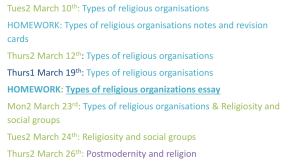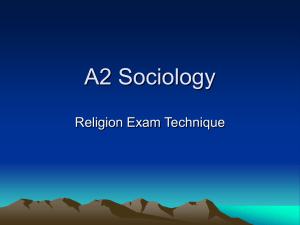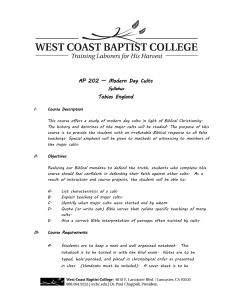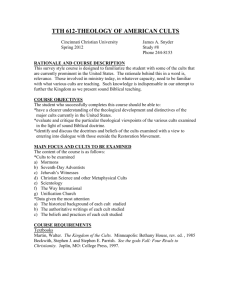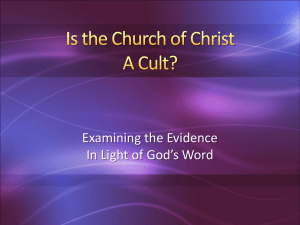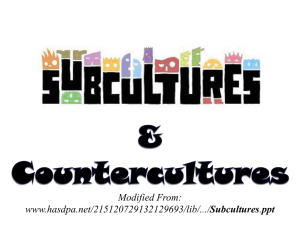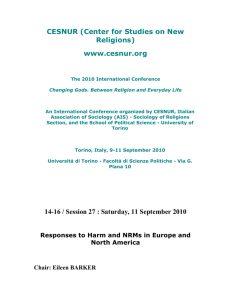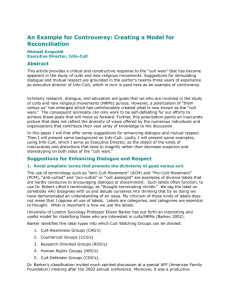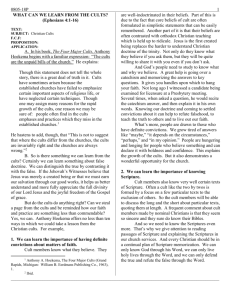Typology of Organised Religion (Church, Sect, Denomination, Cult)
advertisement
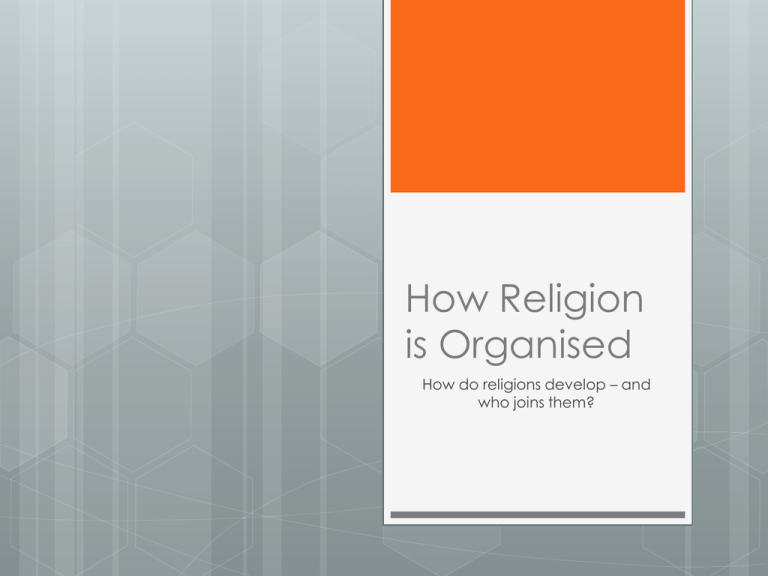
How Religion is Organised How do religions develop – and who joins them? Learning Objectives 1. Describe the key features and differences between four types of religious organisation: Church Denomination Sect Cult 2. Identify two examples of a religious group belonging to each type 3. Explain the origins and key beliefs of a chosen religious cult 4. Describe the following two cult-related movements: Cult apologists The anti-cult movement You will need your Sociology handbook (the blank grid)! Which organisations do the following represent? The Typology* of Religious Organisations Church Denomination Sect Cult In Pairs: Discuss – which of the above have you heard of and what do they mean? * A typology is a system of classifying things into ideal ‘types’ Church vs. Sect Early typologies, such as those described by Weber (nd) and Troeltsch (1912), differentiated between churches and sects. 1. Church “A well-established religious body” – Troeltsch (1912) Not a building!!! We would associate the concept of ‘church’ with the “big”, old, global religions. Features of a Church 1. 2. 3. 4. Universal appeal; members from all social classes. Complex hierarchy of paid officials Huge! National or international. Accept the norms and values of society; usually close relationship to the State. 5. The level of members’ involvement varies; often members don’t need to do much at all! 6. Claims a monopoly on truth Examples: The Roman Catholic Church, Islam, Hinduism Evaluation Point: “The Church is Obsolete” (Bruce; 1996) The concept of ‘church’ is outdated in most modern societies… Countries like the UK have religious pluralism and the ‘churches’ are tolerant of other religions, no longer claiming a monopoly of truth… The connection between Church and State is disappearing. COE close to extinction http://www.youtube.com/watch?v=dEPp4xeFZPA 2. Sect A sect is a small, exclusive group which people are not usually born into – they ‘choose’ to join. Sects usually are created when a group breaks away from a church (or denomination) due to a disagreement or different way of understanding something. Features of a Sect 1. Membership mainly comes from lower social classes 2. No hierarchy of paid officials; often a single, charismatic leader 3. Small; strongly integrated 4. Challenge the norms and values of society; oppose the State 5. Members are expected to make a deep commitment; sometimes expected to withdraw from society 6. Claim a monopoly of truth Examples: Jehovah’s Witnesses, Amish, Mormons http://www.youtube.com/watch?v=tBhnyIV Wwl4 Watch the clip and read the Jonestown handout: Complete the activity. Exam Question: 15 mins Identify & Explain two differences between a church and sect [17] Remember: Two paragraphs Introduce the difference Explain Evidence/Further Explanation Example Denominations & Cults The typology gets more complicated… In the 1920s, Niebuhr compared sects with denominations. More recently, the concept of cult was added to some typologies. 3. Denominations Denominations are offshoots of established churches. Becker (1950) argues that denominations are sects that have ‘cooled down’. Features of Denominations 1. 2. 3. 4. 5. 6. Membership tends to be from the middle-classes Hierarchy of paid officials; bureacratic National or international Do not identify with the state Little pressure on members to participate Do not claim a monopoly of truth; usually practice religious tolerance Examples: Methodists, Baptists, Pentecostalists Further Points Sects become denominations because, once the charismatic leader has died, they need to establish a bureaucratic, hierarchical structure to survive (Niebuhr) Many sects do survive for a long time without becoming denominations (Wilson) 4. Cults The least coherent form of religious organisation A bringing-together of like-minded individuals; people don’t usually formally ‘join’. Hard to differentiate from sects. Many sociologists now describe cults as either NRMs or NAMs. Features of a Cult 1. Membership usually middle-class (rarely any diversity within the group) 2. No hierarchy; usually a single, charismatic leader 3. Can be local, national or international 4. Some are critical of society, others accept it: All have a unique approach which offers something new 5. Membership is usually flexible; easy to join, easy to leave 6. No monopoly on truth; simply offer ‘a’ truth (usually) Examples: Scientology, transcendental meditation Cults & Moral Panics Cults have often been the centre of moral panics. Extreme examples have led to the concept having very negative connotations. https://www.youtube.com/watch?v=bFQpblt2y vw https://www.youtube.com/watch?v=v4qZB2ytq 10 Cult-Related Movements Cult Apologists • Defend the right of cults to exist • Claims they are misunderstood and only seem strange because people don’t know enough about them • Accuses their critics of spreading lies and fear The Anti-Cult Movement • Concerned about cults (often made up of parents or exmembers) • Some anti-cult members become deprogrammers (‘kidnapping’ members and forcing them to abandon their beliefs) Group Research In groups, research one of the following and prepare a 5 minute presentation to the class. The Divine Light Mission The Unification Church (Moonies) The Church of Scientology The Children of God Hare Krishna Typology of Religious Organisations: Evaluative Points The typology is vague, confusing and should be abandoned (Stark & Bainbridge; 1985). For example, Scientology is called a ‘cult’ but doesn’t really fit into any of the types. The typology is also accused of being ethnocentric (too focused on Christian examples) Homework Essay or Blog Religious cults and sects should have freedom to believe and practice whatever they want. Using evidence from this section, write a short essay (500-1000 words) that either supports or refutes this viewpoint.
